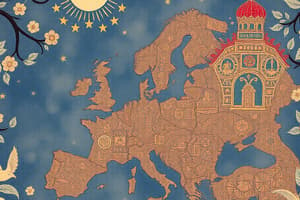Podcast
Questions and Answers
The Lomé Agreements, established in 1975, are MOST significant for:
The Lomé Agreements, established in 1975, are MOST significant for:
- Establishing a military alliance between the EC and ACP countries.
- Creating trade and aid partnerships between the EC and ACP countries, offering trade preferences and development aid. (correct)
- Standardizing the political systems across the European Community and ACP nations.
- Facilitating the free movement of labor between Europe and the ACP countries.
How did the 1970s oil crisis MOST directly contribute to the development of the European Political Cooperation (EPC)?
How did the 1970s oil crisis MOST directly contribute to the development of the European Political Cooperation (EPC)?
- It highlighted Europe's dependence on Middle Eastern oil, revealing the necessity for a coordinated European foreign policy. (correct)
- It caused a split among European nations, preventing any possibility of coordinated action.
- It led to the immediate formation of a unified European military force to protect oil interests.
- It demonstrated the success of individual national policies, proving that a coordinated European response was unnecessary.
Which of the following BEST describes the primary aim of Willy Brandt's Ostpolitik?
Which of the following BEST describes the primary aim of Willy Brandt's Ostpolitik?
- To militarily confront the Soviet Union and its satellite states.
- To isolate East Germany economically and politically.
- To promote the spread of capitalism throughout Eastern Europe by force.
- To normalize relations between West Germany and Eastern Bloc countries, fostering communication, trade, and stability. (correct)
Henry Kissinger's famous question, 'With whom do I speak for Europe?', MOST directly reflects which challenge faced by the European Community in the 1970s?
Henry Kissinger's famous question, 'With whom do I speak for Europe?', MOST directly reflects which challenge faced by the European Community in the 1970s?
How did the Single European Act of 1987 MOST significantly advance the European Political Cooperation (EPC)?
How did the Single European Act of 1987 MOST significantly advance the European Political Cooperation (EPC)?
Which of the following best describes the primary purpose of the EU Military Committee, as established by the Nice European Council in 2000?
Which of the following best describes the primary purpose of the EU Military Committee, as established by the Nice European Council in 2000?
How did the European Security Strategy (2003) differ from the US "Bush Doctrine" (2002) in its approach to global security challenges?
How did the European Security Strategy (2003) differ from the US "Bush Doctrine" (2002) in its approach to global security challenges?
Which of the following was NOT identified as a key security challenge in the European Security Strategy (2003)?
Which of the following was NOT identified as a key security challenge in the European Security Strategy (2003)?
What is the main objective of the European Defence Agency (EDA), established in 2004?
What is the main objective of the European Defence Agency (EDA), established in 2004?
How did the Lisbon Treaty (2009) aim to strengthen the EU's foreign policy coordination?
How did the Lisbon Treaty (2009) aim to strengthen the EU's foreign policy coordination?
What does the concept of "Principled Pragmatism," as outlined in the EU Global Strategy, refer to?
What does the concept of "Principled Pragmatism," as outlined in the EU Global Strategy, refer to?
Under the Lisbon Treaty, the legally binding framework aimed at enhancing coordination, increasing investments, and fostering more defense cooperation is known as:
Under the Lisbon Treaty, the legally binding framework aimed at enhancing coordination, increasing investments, and fostering more defense cooperation is known as:
What was the primary aim of establishing the CFSP as the EU's second pillar under the Maastricht Treaty?
What was the primary aim of establishing the CFSP as the EU's second pillar under the Maastricht Treaty?
The Petersberg Tasks, defined within the context of the EU's developing security policy, primarily focused on which type of operations?
The Petersberg Tasks, defined within the context of the EU's developing security policy, primarily focused on which type of operations?
What key provision did the European Security and Defence Identity (ESDI), established in 1996, offer to the EU for its military operations?
What key provision did the European Security and Defence Identity (ESDI), established in 1996, offer to the EU for its military operations?
What was the main objective for creating the High Representative for CFSP, a role first held by Javier Solana in 1999?
What was the main objective for creating the High Representative for CFSP, a role first held by Javier Solana in 1999?
What was the significance of the Franco-British St. Malo Summit of 1998 in the context of European defense policy?
What was the significance of the Franco-British St. Malo Summit of 1998 in the context of European defense policy?
What did the Helsinki Headline Goal, established in 1999, aim to provide the EU with by 2003?
What did the Helsinki Headline Goal, established in 1999, aim to provide the EU with by 2003?
What was the aim of the Civilian Headline Goal 2000, complementing military efforts?
What was the aim of the Civilian Headline Goal 2000, complementing military efforts?
How did the Amsterdam Treaty (1997) seek to improve the EU's foreign policy decision-making processes?
How did the Amsterdam Treaty (1997) seek to improve the EU's foreign policy decision-making processes?
Flashcards
Ostpolitik
Ostpolitik
German initiative led by Willy Brandt to improve West Germany's relations with Eastern bloc countries, promoting communication, trade, and stability.
Lome Agreements
Lome Agreements
Agreements in 1975 establishing trade and aid partnerships between the European Community and African, Caribbean, and Pacific countries, offering trade preferences and development aid.
European Council Meetings
European Council Meetings
Regular meetings of EU member states' heads of state or government to set strategic priorities and address key issues, advancing political coordination.
COREU
COREU
Signup and view all the flashcards
Civilian Power Europe
Civilian Power Europe
Signup and view all the flashcards
Nice European Council (2000)
Nice European Council (2000)
Signup and view all the flashcards
EU-NATO Declaration (2002)
EU-NATO Declaration (2002)
Signup and view all the flashcards
European Security Strategy (2003)
European Security Strategy (2003)
Signup and view all the flashcards
Normative Power Europe
Normative Power Europe
Signup and view all the flashcards
European Defence Agency (EDA)
European Defence Agency (EDA)
Signup and view all the flashcards
HR/VP (High Representative/Vice President)
HR/VP (High Representative/Vice President)
Signup and view all the flashcards
Permanent Structured Cooperation (PESCO)
Permanent Structured Cooperation (PESCO)
Signup and view all the flashcards
Maastricht Treaty (1992)
Maastricht Treaty (1992)
Signup and view all the flashcards
ESDI (1996 Berlin)
ESDI (1996 Berlin)
Signup and view all the flashcards
High Representative for CFSP
High Representative for CFSP
Signup and view all the flashcards
St. Malo Summit (1998)
St. Malo Summit (1998)
Signup and view all the flashcards
NATO's Kosovo intervention (1999)
NATO's Kosovo intervention (1999)
Signup and view all the flashcards
Helsinki Headline Goal (1999)
Helsinki Headline Goal (1999)
Signup and view all the flashcards
Civilian Goal (2000)
Civilian Goal (2000)
Signup and view all the flashcards
Petersberg Tasks
Petersberg Tasks
Signup and view all the flashcards
Study Notes
- In the 1970s, the European Political Cooperation (EPC) was initiated during the Cold War's détente period, relaxing tensions between the US and the Soviet Union.
- Willy Brandt's Ostpolitik, a German initiative, aimed to improve relations with the Soviet Union and normalize relations between West Germany and Eastern Bloc countries, promoting communication, trade, peace, and stability in a divided Europe.
- The UK joined in 1973, signaling the growing appeal and role of the European Communities in Western Europe both politically and economically.
- The Lomé Agreements were signed in 1975, establishing trade and aid partnerships between the EC and ACP countries, providing trade preferences for ACP countries to export to the EC without tariffs, along with development aid.
- The 1970s Petrol Crisis revealed Europe's vulnerability to external shocks, highlighting the need for a coordinated foreign policy, which triggered discussions on EPC to collectively address economic and political crises.
- Regular summits of the European Council were initiated, where heads of state or government of EU member states meet to set strategic priorities, marking progress towards greater political coordination and unified decision-making in the EU
- Foreign ministers began coordinating international stances to present a united front, using COREU, a communication network, to facilitate quick information exchange and lay the groundwork for the Common Foreign and Security Policy (CFSP).
- Henry Kissinger's question, "With whom do I speak for Europe?", exposed the lack of European unity and excessive fragmentation in diplomacy.
- François Duchêne's Civilian Power Europe promoted Europe's role as a global civilian power, emphasizing economic influence, diplomacy, and development aid over military might, reflecting Ditrany's idea of Functionalism.
- The Single European Act (1987) formalized the EPC by structuring a framework for member states to coordinate foreign policy while decision-making remained intergovernmental, ensuring strong control by individual member states and excluding the Commission, EP, or ECJ to avoid supranationalism.
- The Maastricht Treaty (1992) established CFSP as the EU's second pillar, formalizing and expanding European foreign and security issues.
- It introduced common positions, joint actions, and common strategies for security.
- The Western European Union (WEU) provided military capability for crisis management and peacekeeping, supporting a military dimension
- The Petersberg Tasks focused on humanitarian rescue, peacekeeping, and crisis management as priorities for EU military operations.
- Questions arose about NATO's role and potential overlap (WEU/NATO/CFSP triangle), concerning duplication of effort and divided responsibilities.
- In 1996, the Berlin + European Security and Defence Identity (ESDI) allowed the EU to access NATO resources for its own military operations, strengthening EU-NATO collaboration in defense while avoiding duplication.
- The Amsterdam Treaty (1997) created the High Representative for CFSP, first Javier Solana in 1999, to strengthen the coherence and visibility of EU foreign policy and institutionalized warning and policy planning mechanisms to react faster to crises.
- QMV (Qualified Majority Voting) was introduced for some foreign policy decisions to expedite decision-making, excluding military policies.
1990s and Early 2000s
- The Bosnian war (1992-1995) prompted Bill Clinton to emphasize it as a European issue, urging EU countries to take responsibility for peacekeeping and reconstruction, highlighting the need for stronger defense coordination.
- At the Franco-British St. Malo Summit (1998), France and the UK agreed on the need for EU autonomous military capabilities, independent of but still complementing NATO, marking a step toward a common European defense policy.
- NATO's Kosovo intervention (1999) exhibited Europe's reliance on NATO for security operations, exposing the EU's limited military capabilities at the time during a military intervention to stop ethnic cleansing in Kosovo.
- The Helsinki Headline Goal (1999) aimed to have up to 60,000 forces deployable within a month for a year by 2003, while the Civilian Goal (2000) aimed to deploy 5,000 civilian experts to support post-conflict stabilization.
- The Nice European Council (2000) introduced structures like the Political and Security Committee (PSC), EU Military Committee, and EU Military Staff to facilitate decision-making and planning for EU-led operations, also allowing for operations independent of NATO.
- The EU-NATO Declaration (2002) formalized cooperation between the EU and NATO, defining resource sharing and coordination of military operations to avoid duplication.
- The European Security Strategy (2003), developed in response to the US "Bush Doctrine" (2002) emphasizing unilateral action, pre-emptive strikes, and a focus on combating materials increasing during War on Terror.
- The European Security Strategy identified terrorism, weapons of mass destruction (WMD), regional conflicts, organized crime, and state failure as five security challenges.
- It advocated for multilateralism and international law as the EU's guiding principles, in line with Normative Power Europe (lan Manners, 2002), as well as promoting norms like human rights and abolishing the death penalty globally.
- The first EU military missions with NATO resources in the W. Balkans (2003) and without NATO resources in Congo (2004).
- The European Defence Agency (EDA), excluding Denmark (and UK); comprising 26 countries, to facilitate and support Defence Cooperation and capabilities.
- The European Defence Fund co-finances the defense industry and research projects.
- In 2009, the Lisbon Treaty established the role of HR/VP to strengthen foreign policy coordination.
- The European External Action Service (EEAS) was established to provide staff from the Commission, Council Secretariat, and National Foreign Ministries.
- The EU Global Strategy balanced principled pragmatism by core values with both realistic and effective foreign policy actions.
- Permanent Structured Cooperation (PeSCO) is a legally binding framework for enhancing coordination, increasing investments, and additional defense cooperation under the Lisbon Treaty and Common Security and Defence Policy (CSDP).
- Participation in PeSCO is voluntary for member states, and decision-making remains in the hands of the participating Member States in the Council.
- Examples of PeSCo projects include Network of Logistic Hubs, Cyber Rapid Response Teams, and Joint EU Intelligence School.
PeSCo and Third States
- Third states can participate in PeSCo projects under certain conditions.
- Only EU MS committed to binding defense obligations.
- Third states must respect the decision-making autonomy of the EU and not undermine PeSCo's goals
- The War in Ukraine raised questions about the protection of neutral EU member states, as they are not covered by NATO's article 5.
- Germany and other EU states have increased military investments, similar to the COVID-19 rescue package.
- The European Peace Facility has a €5 billion fund for rapid crisis response and urgent military assistance.
Studying That Suits You
Use AI to generate personalized quizzes and flashcards to suit your learning preferences.




